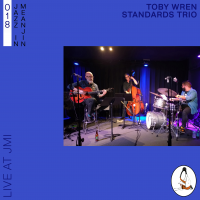Home » Jazz Musicians » Milton Nascimento
Milton Nascimento
Multitalented Milton Nascimento is frequently acclaimed as Brazil's greatest musician. As a singer/songwriter, he weaves a startling blend of musical influences, including Brazilian and African folk strains, European classical music, and the Brazilian bossa nova. His Portuguese lyrics range from themes of universal love and the spiritual unification of the child and adult, to expressions of the struggle of oppressed people in Latin America and throughout the world. He has collaborated with and inspired numerous Latin American musicians, and has won the admiration of diverse American artists, including jazzmen Wayne Shorter, Herbie Hancock, and Pat Metheny.
Nascimento was raised in the small town of Tres Pontas, in the Brazilian state of Minas Gerais. It was in his isolated village that Nascimento developed his "sophisticated harmonic sense." Nascimento traveled to Sao Paulo in 1965, and as an unknown bass player struggled to find work in a saturated club scene. His compositions began to gain recognition, however, and the famous Brazilian singer Elis Regina, who recorded several of his songs, secured him a performance on a national television music program. His big break came in 1967, however, when three of his songs were showcased at the prestigious First International Pop Song Festival in Rio de Janeiro. After his impressive showing in the song festival, he became highly sought after by recording companies in Rio. Nascimento's first two albums, “Travessia,” (1967) and “Milton Nascimento,” (1969) established him as a major new talent in Brazil, and with his 1969 A&M album “Courage,” he was touted to American musical audiences as the successor to bossa nova stars such as Joao Gilberto and Antonio Carlos Jobim.
Musicians throughout Latin America have traveled to Brazil to work with Nascimento, as have many from the United States. Jazz saxophonist Wayne Shorter met Nascimento in 1974 and the following year their collaborative “Native Dancer,” was released, an album that many consider to be one of the most influential jazz recordings of the 1970s. He followed up with “Geraes,” (1976), which ranks as one of his best, “Milton,” (1977) featuring Airto Moreira, Herbie Hancock, Raul de Souza and Wayne Shorter, and the double-album “Clube Da Esquina,” (1&2)(1978) was a landmark collaboration recreating the street music scene he was a part of in Minas Gerais.
Nascimento's 1982 “Missa dos Quilombos,” is a mass- oratorio dedicated to the story of blacks in Brazil from slavery to current times. His 1991 album “Txai,” focuses on the plight of indigenous peoples of the Amazon basin and the destruction of the rain forest, and it incorporates the haunting folk music of several jungle tribes.
Read moreTags
Milton Nascimento & Esperanza Spaulding, Andrew Bird, Jake Blount & Mali Obomsawin

by Cliff Furnald
RootsWorld rambles around once more with music from jazz to roots-folk from around the world. Artists in this edition include Milton Nascimento, & Esperanza Spaulding, Lúireach, Satnam Galsian, Les Arrivants, Andrew Bird , Frode Nyvold and friends, Andy Statman Trio , Riccardo Tesi , Besh o droM, Quintet Bumbac, Alterne, and Jake Blount & Mali Obomsawin. ...
Continue ReadingMilton Nascimento And Esperanza Spalding, Das Rad, Louis Stewart And Jim Hall

by Cheryl K.
During this week's two-hour program of Jazz and improvised music, new music from Brazilian singer-songwriter and multi-instrumentalist Milton Nascimento and US bassist and vocalist esperanza spalding, the Fernando Huergo Big Band, the English septet Das Rad, and Irish guitarist Louis Stewart and US guitarist Jim Hall. Playlist Wayne Shorter “Tarde" from Native Dancer (Columbia) 5:46 Milton Nascimento and esperanza spalding “Saudade Dos Aviões Da Panair (Conversando No Bar)" from Milton + esperanza (Concord) 5:24 Lucian Ban, Mat Maneri ...
Continue ReadingMilton Nascimento, Esperanza Spalding, Joe Tatton, Benjamin Koppel & More

by Ludovico Granvassu
Enjoy an episode of Mondo Jazz full of stellar collaborations, Puerto Rican rumbles, Brazilian waves, birthday celebrations, unearthed gems, and infectious grooves.Happy listening!Playlist Ben Allison “Mondo Jazz Theme (feat. Ted Nash & Pyeng Threadgill)" 0:00 Joe Tatton Trio “Double Take" Galáctico (Rodina) 0:16 Host talks 3:38 George Benson feat. The Robert Farnon Orchestra “Love Is Blue" Dreams Do Come True: When George Benson Meets Robert Farnon (Warner) 5:36 Host talks 9:50 Ben Sidran “Panda" Rainmaker (Bonsaï) ...
Continue ReadingMilton Nascimento / Esperanza Spalding: Milton + esperanza

by Chris May
Sometimes the semiology around an album can tell you more about it than any amount of words attempting to describe the music itself. And the semiology around Milton + esperanza is eloquent. It begins with the overlap with another summer 2024 release, Wayne Shorter's magical double-album Celebration Volume 1 (Blue Note), a previously unreleased recording of Shorter's Quartet in concert in 2014, with liner notes written by Shorter's wife Carolina. Now consider the overlap. Wayne Shorter recorded with ...
Continue ReadingTorino Jazz Festival 2022

by Antonio Baiano
A collection of photos from the Torino Jazz Festival in Torino, Italy from June 11, 2022 to June 19, 2022 featuring Milton Nascimento, Buster Williams, Lenny White, Jan Bang, Arve Henriksen, Roberto Cecchetto, Michele Rabbia, Kurt Rosenwinkel, Jason Lindner and Jimi Tenor. ...
Continue ReadingMilton Nascimento at Carnegie Hall

by Ernest Barteldes
Milton Nascimento Carnegie Hall New York, New York November 18, 2009
To celebrate the 25th anniversary of his first Carnegie Hall appearance, Milton Nascimento presented exactly what his many fans were hoping for: an evening filled with many of his greatest hits, including a few numbers he hadn't played live in quite a few years. “it is a blessing to play here," he declared in English halfway through the set, acknowledging the passing ...
Continue ReadingMilton Nascimento and The Jobim Trio at the University of Michigan

by C. Andrew Hovan
Milton Nascimento and The Jobim Trio University of Michigan, Hill Auditorium Ann Arbor, Michigan October 18, 2008
It's not often that all-star groups assembled to honor a particular milestone manage to coalesce in a manner that transcends the novelty factor to become a satisfying listening experience. But this is just exactly what has happened with the brilliant pairing of Brazilian star Milton Nascimento with the Jobim Trio. The unique ensemble first came together in ...
Continue ReadingRenowned Brazilian Composer And Pianist Antonio Adolfo Releases "BruMa - Celebrating Milton Nascimento"

Source:
Mouthpiece Music
Antonio Adolfo is one of the premier pianists, composers, and arrangers to emerge from Brazil, a country rife with exceptional musical talent. A prolific recording artist, Adolfo is now releasing BruMa: Celebrating Milton Nascimento. A multi-Latin Grammy and Grammy nominee, Antonio Adolfo is an internationally recognized Latin jazz star. He met singer and composer Milton Nascimento in 1967 at the Second International Song Festival (FIC) in Rio de Janeiro, the biggest musical contest event in Brazil, where both participated. The ...
read more
Brazilian Vocalist Carol Saboya To Make U.S. Solo Debut With "Belezas: The Music Of Ivan Lins & Milton Nascimento"

Source:
Terri Hinte Publicity
Already established as a premier recording artist in her native Brazil and in Japan, with eight albums to her credit, vocalist Carol Saboya is poised to make her U.S. solo debut with the July 10 release of Belezas: The Music of Ivan Lins and Milton Nascimento. The CD, on the AAM Music label, features guest appearances by saxophonist Dave Liebman and harmonica master Hendrik Meurkens, and was produced and arranged by renowned pianist (and Saboya’s father) Antonio Adolfo. Having previously ...
read more
Jazz Musician of the Day: Milton Nascimento

Source:
All About Jazz is celebrating Milton Nascimento's birthday today!
Multitalented Milton Nascimento is frequently acclaimed as Brazil\'s greatest musician. As a singer/songwriter, he weaves a startling blend of musical influences, including Brazilian and African folk strains, European classical music, and the Brazilian bossa nova. His Portuguese lyrics range from themes of universal love and the spiritual unification of the child and adult...Multitalented Milton Nascimento is frequently acclaimed as Brazil\'s greatest musician. As a singer/songwriter, he weaves a startling blend of ...
read more
Carnegie Hall Presents Brazilian Singer/Guitarist Milton Nascimento in Stern Auditorium/Perelman Stage on November 18 at 8:00 PM

Source:
Michael Ricci
Celebrated Brazilian singer, songwriter, and guitarist Milton Nascimento gives a rare New York performance in Carnegie Hall's Stern Auditorium/Perelman Stage on Wednesday, November 18 at 8:00 p.m. Recognized for his distinctive falsetto, tonal range, and intimate singing style, Nascimento has won international acclaim not only for his works in world music, but also in pop and jazz genres through collaborations with arists ranging from Wayne Shorter and Pat Metheny to James Taylor and Sting. The Grammy and Latin Grammy Award-winning ...
read more
Milton Nascimento & the Jobim Trio at NJPAC on October 26

Source:
All About Jazz
Tom Jobim said that Milton Nascimento was the only singer capable of reaching the original pitches of his compositions. Nothing more appropriate, therefore, than Milton Nascimento joining the Jobim Trio to celebrate bossa nova's 50th anniversary with the new Blue Note Records release, Novas Bossas. Milton and the Jobim Trio (featuring guitarist Paulo Jobim; pianist Daniel Jobim; and drummer Paulo Braga) will be appearing at the New Jersey Perfoming Arts Center, Prudential Hall on Sunday, October 26. The seeds for ...
read more
Milton Nascimento Exclusive at NJPAC, Paquito D'Rivera

Source:
All About Jazz
NJPACs Alternate Routes & Arts Education present Encuentro!, a Latin Jazz Weekend
With Milton Nascimento & The Jobim Trio in a NY/NJ Exclusive (10/26) Paquito D'Rivera (10/25) Latin Jazz Dance Party (10/24)
10/24/08 Baila Mi Gente Latin Jazz Dance Party, 7:30pm, Victoria Theater, $28 10/25/08 Paquito DRivera, 7:30pm, Victoria Theater, $39 10/26/08 Milton Nascimento & The Jobim Trio, 5pm, Prudential Hall, $18-$60
NJPACs Alternate Routes Series and Arts Education Department team up ...
read more







































.jpg)



















